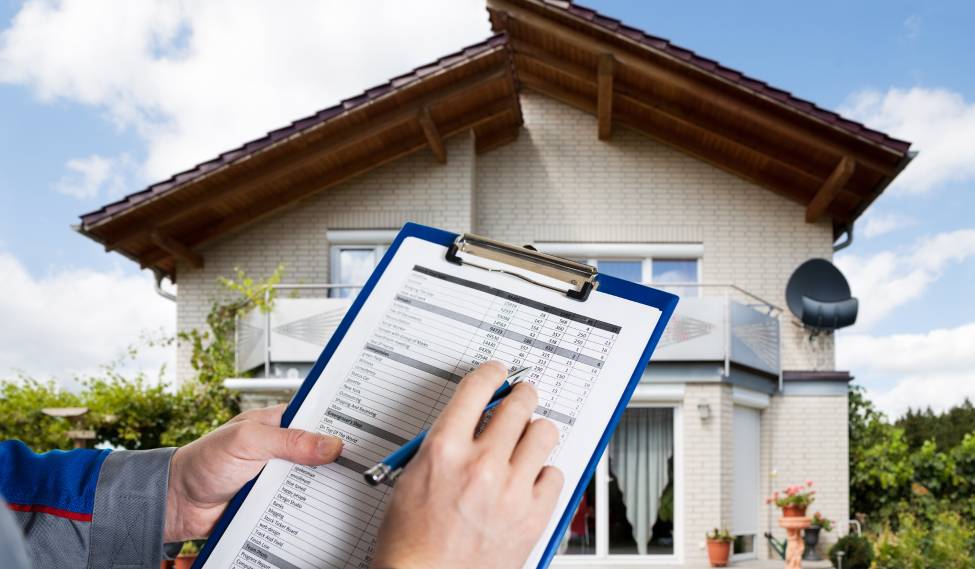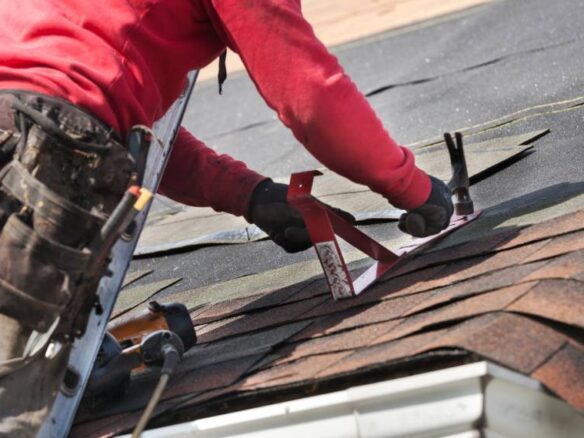When buying or selling a home, one of the most important steps in the process is the home inspection. This thorough evaluation of the property can provide valuable insights into its condition and any potential issues that may need to be addressed. However, for many homeowners and buyers, the thought of a home inspection can be daunting.
With so much information to process and a potentially lengthy report to navigate, it can be overwhelming to know where to start. That’s why we’ve created this step-by-step guide to navigating the 4-point home inspection with ease.
Understanding 4-Point Home Inspection
As you can guess by the name, a 4-Point Home Inspection is a kind of home inspection in which 4 key areas of a house – roof, electrical, plumbing, and HVAC – are inspected under the request of home insurance providers.
In this article, we’ll break down these four main areas that are typically covered in a home inspection and provide tips on how to prepare for each one. By following our guide, you can gain a better understanding of what to expect during a home inspection and be better equipped to ask questions and address any concerns that may arise. So let’s dive in and learn how to navigate the 4-point home inspection process with confidence and ease.
How To Prepare For A 4-point Home Inspection
Gather All Necessary Documents Beforehand
Before scheduling a 4-point home inspection, it is crucial to gather all necessary documents beforehand. This will help streamline the inspection process and ensure that all required information is readily available for the inspector. Start by compiling the property’s insurance documents, including policy details and any previous claims.
Additionally, gather all maintenance records, such as receipts for repairs or upgrades made to the electrical, plumbing, HVAC, and roofing systems. It is also important to provide any relevant permits or certificates of compliance for previous renovations. By having these documents prepared in advance, you can demonstrate your commitment to maintaining a safe and well-maintained home, increasing the likelihood of a successful inspection.
Check For Common Issues Beforehand
To increase your chances of passing a 4-point home inspection with ease, it is recommended to check for common issues beforehand. Start by inspecting the electrical system for any outdated or faulty wiring, as well as ensuring that all outlets and switches are functioning properly.

Next, examine the plumbing system for leaks, water pressure problems, or any signs of corrosion in pipes. It is also important to assess the condition of the HVAC system, checking for any malfunctioning units or inadequate cooling/heating throughout the house.
Lastly, inspect the roof for any visible damage, such as missing shingles or signs of leaks. By addressing these common issues before the inspection, you can ensure that your home meets the necessary requirements and increase the likelihood of a successful outcome.
Ensure Proper Labeling Of Utilities
One important aspect of preparing for a 4-point home inspection is to ensure proper labeling of utilities. This includes clearly identifying electrical panels, water shut-off valves, and gas lines throughout the property. By accurately labeling these essential components, you not only demonstrate a commitment to safety but also make it easier for inspectors to assess the condition and functionality of these systems.
Additionally, having clear and visible labels can help homeowners and future occupants quickly locate and operate these utilities in case of an emergency or routine maintenance. Properly labeled utilities not only contribute to a successful inspection but also promote overall safety and convenience within the home.
Be Prepared For Follow-Up Questions
Being prepared for follow-up questions during a 4-point home inspection is crucial to ensure a smooth and efficient process. Inspectors may ask for additional information or clarification regarding certain aspects of the property, such as the age of major systems, recent repairs or upgrades, or the history of any previous issues.
To be ready for these inquiries, it is recommended to gather all relevant documents, including maintenance records, warranties, and permits. Familiarize yourself with the property’s history and any work done on it, as well as any potential issues that may arise.
By being well-informed and organized, you can confidently address any follow-up questions and provide the necessary information to help the inspector assess the home accurately. This level of preparedness will not only facilitate a successful inspection but also increase your chances of passing a 4-point home inspection with ease.
Hire A Professional If Needed
While it is important to be knowledgeable and prepared for a 4-point home inspection, it is equally important to recognize when you may need the expertise of a professional. If you encounter complex or unfamiliar issues during the inspection process, or if you are unsure about the condition of certain systems or components in your home, it is highly recommended to hire a professional for further evaluation.

Licensed contractors, engineers, or specialists can provide valuable insights and expertise in areas such as electrical, plumbing, HVAC, and roofing systems. Their expertise can help identify any potential hazards, assess the overall condition of your home, and provide recommendations for necessary repairs or upgrades.
By seeking professional assistance when needed, you can ensure the accuracy and thoroughness of the inspection, and ultimately increase your chances of successfully passing a 4-point home inspection.
How To Pass A 4-point Home Inspection
Prepare For The Inspection Beforehand
In order to increase your chances of passing a 4-point home inspection with flying colors, it is essential to adequately prepare beforehand. Start by conducting a thorough assessment of your home, examining key areas such as the roof, electrical system, plumbing, and HVAC.
Look out for any visible damages or issues that might raise red flags during the inspection. Engaging the services of a professional contractor or inspector beforehand can provide valuable insights and help you identify potential problem areas that may need attention.
Additionally, gather and organize all necessary documentation relating to the home’s maintenance and repairs, including permits and warranties. By taking proactive measures to address any existing issues and gathering the necessary paperwork, you can demonstrate to the inspector that your home is well-maintained and in compliance with the necessary standards.
Address Any Necessary Repairs Promptly
One key strategy to ensure a smooth and successful 4-point home inspection is addressing any necessary repairs promptly. It is crucial to tackle any visible damages or issues in your home as soon as they arise. Ignoring or delaying repairs not only increases the risk of further damage but also raises red flags during the inspection process.
Take the time to assess your home regularly, keeping an eye out for any signs of wear and tear, leaks, electrical malfunctions, or structural weaknesses. By promptly addressing these repairs, you not only improve the overall safety and functionality of your home but also demonstrate to the inspector that you are proactive in maintaining your property.
Gather All Necessary Documentation
Having all the necessary documentation is another crucial aspect of successfully passing a 4-point home inspection. Before the inspection takes place, gather all relevant paperwork, including permits, warranties, and maintenance records. These documents provide valuable evidence that your home has been well-maintained and any necessary repairs have been addressed.
Additionally, make sure to have copies of insurance policies, as the inspector may request proof of coverage to ensure your home is adequately protected. By having these documents readily available, you not only streamline the inspection process but also demonstrate your commitment to maintaining your property in a responsible and organized manner.
Be Present During The Inspection
During the 4-point home inspection, it is highly recommended to be present and actively participate in the process. Being present allows you to gain a firsthand understanding of the condition of your home and ask any questions you may have.
By accompanying the inspector throughout the inspection, you can learn about potential issues and necessary repairs, which can be addressed promptly. Additionally, being present demonstrates your commitment to maintaining your home and ensures that the inspector has access to all areas, including crawl spaces and attics, which may require your assistance.
By actively participating in the inspection, you can ensure a smooth and successful process, gaining valuable insights into the overall condition of your property and taking necessary steps for any required improvements.
Follow Up On Any Recommendations
After the completion of the 4-point home inspection, it is crucial to follow up on any recommendations provided by the inspector. These recommendations are based on their evaluation of the four main areas: the electrical, plumbing, HVAC, and roof systems. It is important to take these recommendations seriously and address any issues or repairs promptly to ensure the safety and functionality of your home.
Ignoring or delaying necessary repairs can lead to further damage and potentially more expensive fixes down the line. By following up on the inspector’s recommendations, you can proactively maintain your home and minimize the risk of future problems. Whether it’s upgrading outdated electrical systems, fixing plumbing leaks, servicing HVAC units, or repairing roof damage, taking action on these recommendations will help ensure a smooth and successful 4-point home inspection.
How Long Does A 4 Point Inspection Take?
Normally, a 4-point inspection takes roughly 30 minutes to two hours depending on various factors like the size of the house, the experience of the inspector and the condition of the home. Most of the inspections usually take 20-30 minutes but in some cases, the inspector takes more time to examine each of the four areas of the home in detail, looks for signs of damage, wear and tear, or outdated components
Conclusion
In conclusion, a thorough and comprehensive 4-point home inspection is crucial for both buyers and sellers in the real estate market. By following these proven strategies, you can ensure a smooth and successful inspection process. You can feel confident in the condition of your home and make informed decisions moving forward.
A successful 4-point inspection is a key aspect of a successful real estate transaction, so take the time to properly prepare and execute this important process. Remember, a thorough and well-maintained home can not only save you money in the long run, but also provide peace of mind for you and your family.
FAQ
What are the four main points of a home inspection and why are they important?
The four main points of a home inspection are structural integrity, electrical systems, plumbing systems, and HVAC systems. These points are important because they help identify any potential issues or defects in the home. Structural integrity is crucial to ensure the safety and stability of the property.
Electrical systems are important for safety and to ensure proper functioning. Plumbing systems need to be checked to ensure there are no leaks or clogs. HVAC systems need to be inspected to ensure they are working efficiently and providing proper heating and cooling. These inspections help buyers make informed decisions and avoid costly repairs in the future.
What steps should homeowners take to prepare for a home inspection?
Homeowners should take several steps to prepare for a home inspection. First, they should make sure their house is clean and tidy, as this will give a good impression to the inspector. They should also clear any clutter and ensure all areas of the house are accessible. Homeowners should address any necessary repairs or maintenance issues ahead of time to avoid potential problems during the inspection.
It’s also helpful to gather any necessary documentation, such as permits or warranties, and provide this to the inspector. Finally, homeowners should be prepared to answer any questions the inspector may have and provide access to all areas of the property.
Can you provide a step-by-step guide on how to conduct a thorough inspection of the exterior of a home?
To conduct a thorough inspection of the exterior of a home, follow these steps:
- Start with a visual inspection of the roof, checking for any missing or damaged shingles, signs of sagging, or leaks.
- Examine the walls for cracks, peeling paint, or signs of moisture damage.
- Inspect the windows and doors for proper sealing, functionality, and any signs of water infiltration.
- Check the foundation for cracks, settling, or signs of water damage.
- Inspect the gutters and downspouts for debris, clogs, or damage.
- Check the exterior siding or cladding for any signs of deterioration or rot.
- Look for any signs of pests, such as termites or carpenter ants.
- Inspect the landscaping for proper grading and drainage away from the home.
- Finally, examine any outdoor structures like decks, porches, or fences for stability and signs of damage.
Note: This is a general guide and it’s recommended to hire a professional inspector for a more comprehensive evaluation.
What are some common issues or red flags to look out for during a home inspection?
Some common issues or red flags to look out for during a home inspection include structural problems such as foundation issues, water damage or leaks, electrical and plumbing issues, mold or pest infestations, outdated or faulty HVAC systems, roofing problems, and evidence of poor maintenance or neglect.
It’s important to also pay attention to signs of hidden damage or cover-ups, such as fresh paint or patched walls. Additionally, be wary of any major renovations or additions that were done without proper permits and inspections, as they could lead to code violations or safety concerns.
Are there any specific tools or equipment that homeowners should have on hand during a home inspection?
Yes, homeowners should have a few basic tools and equipment on hand during a home inspection. These include a flashlight to inspect dark or hard-to-reach areas, a ladder for inspecting high places such as the roof or attic, a moisture meter to detect any hidden water damage, a circuit tester for checking electrical outlets, and a basic toolkit for minor repairs or adjustments. Having these tools readily available can help homeowners identify potential issues and make informed decisions about their property.







Join The Discussion